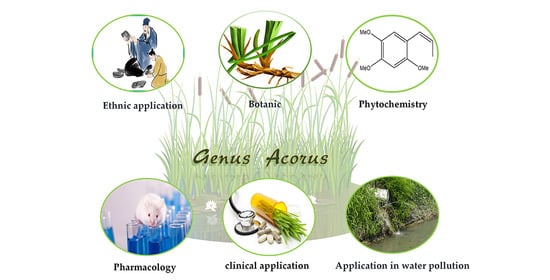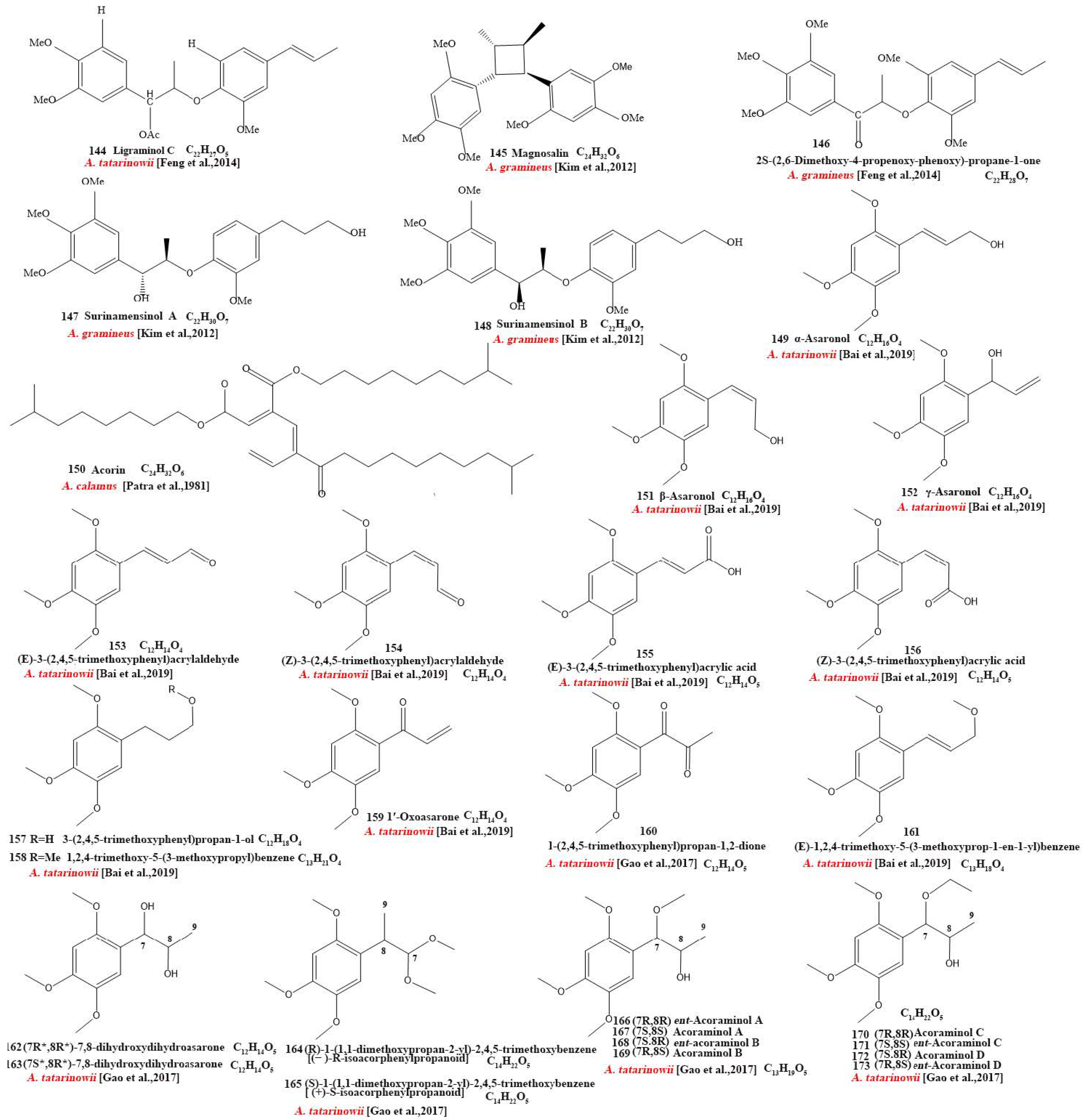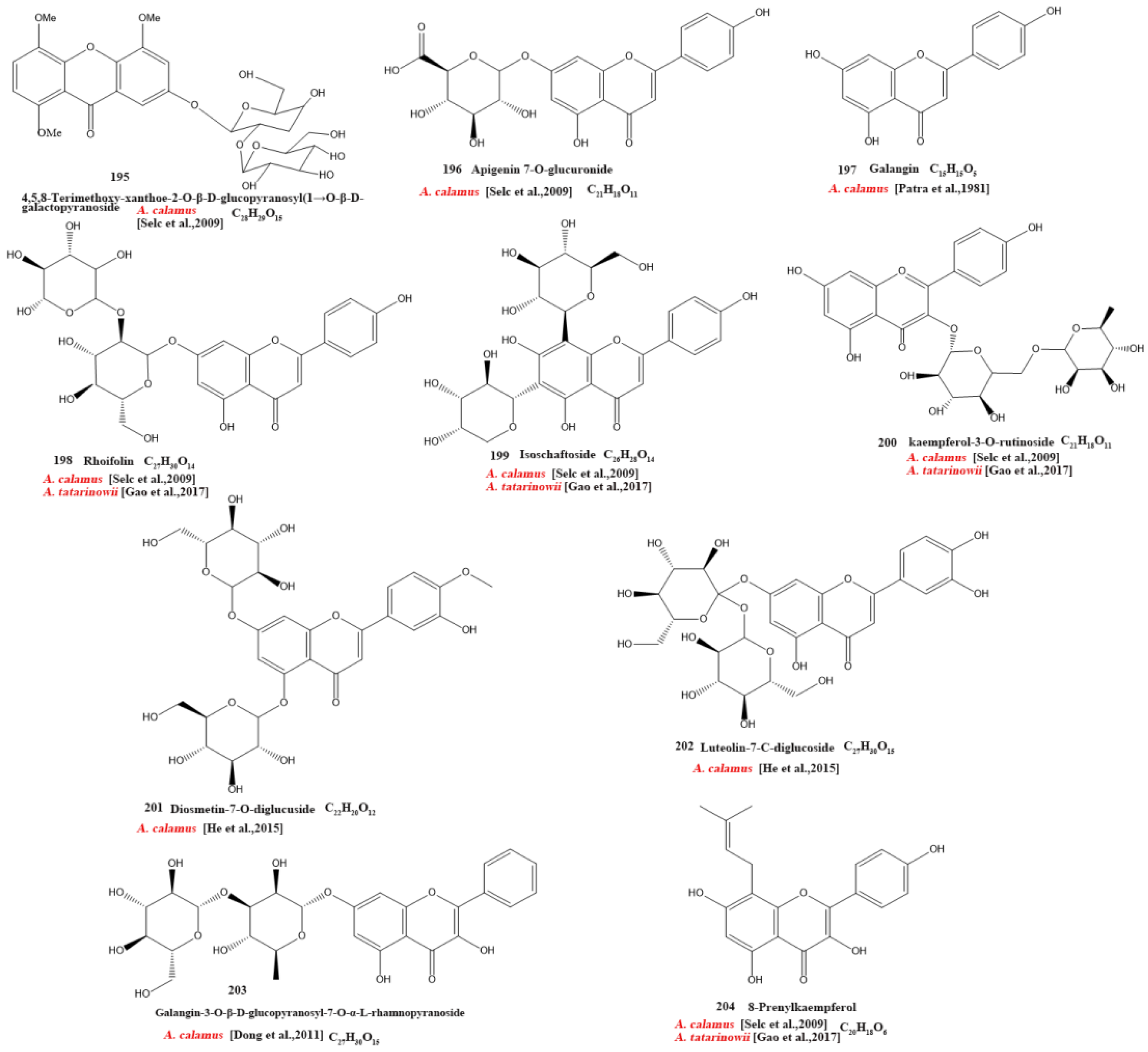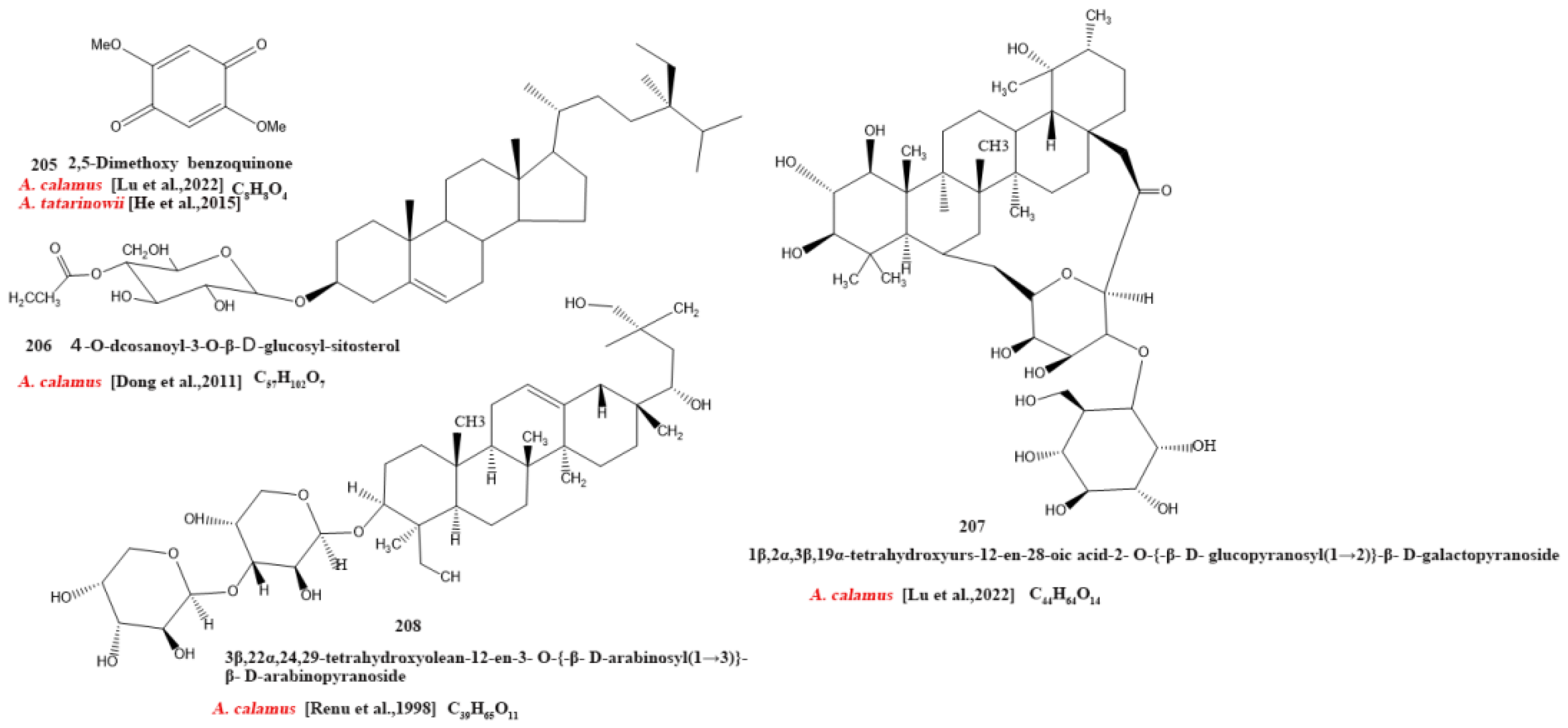Ethnic, Botanic, Phytochemistry and Pharmacology of the Acorus L. Genus: A Review
Abstract
1. Introduction
2. Ethnic Application
3. Botany
4. Chemistry
5. Pharmacology
5.1. Effect on Central Nervous System
5.1.1. Neuroprotective Activity
5.1.2. Anti-Depressant Activity
5.1.3. Protective Activity against Alzheimer’s Disease
5.1.4. Anti-Epileptic Activity
5.2. Anti-Inflammatory Activity
5.3. Anti-Bacterial Activity
5.4. Effect on Cardiovascular System
5.4.1. Myocardial Cell Protection Activity
5.4.2. Anti-Thrombotic Activity
5.4.3. Hypolipidemic Activity
5.4.4. Cardiac Protection Activity
5.4.5. Hypotensive Activity
5.5. Anti-Tumor Activity
5.6. Effect on Digestive System
5.7. Anti-Diabetes Activity
6. Clinical Application
6.1. Respiratory System
6.2. Nervous System
6.3. Digestive System
6.4. Cardiovascular System
6.5. Urinary System
7. Application in Water Pollution Control
8. Discussion
Author Contributions
Funding
Data Availability Statement
Acknowledgments
Conflicts of Interest
Sample Availability
References
- Cheng, Z.; Shu, H.; Zhang, S.; Luo, B.; Gu, R.; Zhang, R.; Ji, Y.; Li, F.; Long, C. From Folk Taxonomy to Species Confirmation of Acorus (Acoraceae): Evidences Based on Phylogenetic and Metabolomic Analyses. Front. Plant Sci. 2020, 11, 965. [Google Scholar] [CrossRef] [PubMed]
- Ryuk, J.A.; Kim, Y.S.; Lee, H.W.; Ko, B.S. Identification of Acorus gramineus, A. calamus, and A. tatarinowii using sequence characterized amplified regions (SCAR) primers for monitoring of Acori graminei rhizoma in Korean markets. Int. J. Clin. Exp. Med. 2014, 7, 2488–2496. [Google Scholar] [PubMed]
- Jadid, N.; Kurniawan, E.; Himayani, C.E.S.; Andriyani; Prasetyowati, I.; Purwani, K.I.; Muslihatin, W.; Hidayati, D.; Tjahjaningrum, I.T.D. An ethnobotanical study of medicinal plants used by the Tengger tribe in Ngadisari village, Indonesia. PLoS ONE. 2020, 15, e0235886. [Google Scholar] [CrossRef] [PubMed]
- Chinese Pharmacopoeia Commission. Pharmacopoeia of the People’s Republic of China, 11th ed.; China Medical Science Press: Beijing, China, 2020.
- Balakrishnan, R.; Cho, D.Y.; Kim, I.S.; Seol, S.H.; Choi, D.K. Molecular Mechanisms and Therapeutic Potential of α- and β-Asarone in the Treatment of Neurological Disorders. Antioxidants 2022, 11, 281. [Google Scholar] [CrossRef] [PubMed]
- Agarwal, S.L.; Arora, R.B.; Dandiya, P.C.; Singh, K.P. A note on the preliminary studies of certain pharmacological actions of Acorus calamus L. J. Am. Pharm. Assoc. Am. Pharm. Assoc. 1956, 45, 655–656. [Google Scholar] [CrossRef] [PubMed]
- Souza, T.D.; Mengi, S.A.; Hassarajani, S.A.; Chattopadhayay, S. Efficacy study of the bioactive fraction (F-3) of Acorus calamus in hyperlipidemia. Indian J. Pharmacol. 2007, 39, 196–200. [Google Scholar]
- Chun, J.H.; Hua, L.W.; Jia, H.W. The effect of Acorus calamus water extract on gastrointestinal motility in mice. Chin. J. Gerontol. 2018, 38, 5046–5048. [Google Scholar]
- You, M.C. Study on purification of urban domestic sewage by Acorus artificial wetland. Environ. Pollut. Prevent. 2010, 32, 54–58. [Google Scholar]
- Yan, X.F.; Chi, Q.H.; Xia, L.; Hai, J.; Zhi, F.M.; Yue, W.Z.; Ya, K.Z. Study on purification effect of aquatic plants on nitrogen and phosphorus in polluted water. J. Water Ecol. 2010, 31, 36–40. [Google Scholar]
- Chi, Q.H.; Ju, X.Y. Study on the effect of Acorus tatarinowii against algae. J. Ecol. 1999, 5, 166–170. [Google Scholar]
- Lee, Y.H.; Kim, D.; Lee, M.J.; Kim, M.J.; Jang, H.S.; Park, S.H.; Lee, J.M.; Lee, H.Y.; Park, C.B.; Han, B.S.; et al. Subchronic toxicity of Acorus gramineus rhizoma in rats. J. Ethnopharmacol. 2016, 183, 46–53. [Google Scholar] [CrossRef] [PubMed]
- Gu, W.; Hao, X.; Wang, Z.; Zhang, J.; Huang, L.; Pei, S. Ethnobotanical study on medicinal plants from the Dragon Boat Festival herbal markets of Qianxinan, southwestern Guizhou, China. Plant Divers. 2021, 42, 427–433. [Google Scholar] [CrossRef] [PubMed]
- Yabesh, J.M.; Prabhu, S.; Vijayakumar, S. An ethnobotanical study of medicinal plants used by traditional healers in silent valley of Kerala, India. J. Ethnopharmacol. 2014, 154, 774–789. [Google Scholar] [CrossRef]
- Panmei, R.; Gajurel, P.R.; Singh, B. Ethnobotany of medicinal plants used by the Zeliangrong ethnic group of Manipur, northeast India. J. Ethnopharmacol. 2019, 235, 164–182. [Google Scholar] [CrossRef] [PubMed]
- Sharma, P.K.; Chauhan, N.S.; Lal, B. Observations on the traditional phytotherapy among the inhabitants of Parvati valley in western Himalaya, India. J. Ethnopharmacol. 2004, 92, 167–176. [Google Scholar] [CrossRef]
- Mahishi, P.; Srinivasa, B.H.; Shivanna, M.B. Medicinal plant wealth of local communities in some villages in Shimoga District of Karnataka, India. J. Ethnopharmacol. 2005, 98, 307–312. [Google Scholar] [CrossRef]
- Mittal, N.; Ginwal, H.S.; Varshney, V.K. Pharmaceutical and biotechnological potential of Acorus calamus Linn: An indigenoushighly valued medicinal plant species. Pharmacogn. Rev. 2009, 3, 83–93. [Google Scholar]
- Malhi, B.S.; Trivedi, V.P. Vegetable Antifertility drugs of India. J. Crude Drug Res. 1972, 12, 1922. [Google Scholar] [CrossRef]
- Singh, M.P.; Malla, S.B.; Rajbhandari, S.B.; Manandhar, A. Medicinal plants of Nepal retrospect’s and prospects. Econ Bot. 1979, 33, 185–198. [Google Scholar] [CrossRef]
- Kumar, H.; Song, S.Y.; More, S.V.; Kang, S.M.; Kim, B.W.; Kim, I.S.; Choi, D.K. Traditional Korean East Asian medicines and herbal formulations for cognitive impairment. Molecules 2013, 18, 14670–14693. [Google Scholar] [CrossRef]
- Raina, V.K.; Srivastava, S.K.; Syamasunder, K.V. Essential oil composition of Acorus calamus L. from the lower region of the Himalayas. Flavour Fragr. J. 2003, 18, 18–20. [Google Scholar] [CrossRef]
- Moerman, D.E. Geraniums for the Iroquois; Reference Publications: Algonac, MI, USA, 1981. [Google Scholar]
- Khwairakpam, A.D.; Damayenti, Y.D.; Deka, A.; Monisha, J.; Roy, N.K.; Padmavathi, G.; Kunnumakkara, A.B. Acorus calamus: A bio-reserve of medicinal values. J. Basic Clin. Physiol. Pharmacol. 2018, 29, 107–122. [Google Scholar] [CrossRef] [PubMed]
- Geng, Q.T.; Jin, Z. The image of Acorus literature in the spread of Chinese culture. Pop. Lit. Art 2022, 15, 28–30. [Google Scholar]
- Ray, T.S. Leaf types in the Araceae. Am. J. Bot. 1987, 74, 1359–1372. [Google Scholar] [CrossRef]
- Michael, H.G. A summary of evidence and arguments supporting the removal of Acorus from the Araceae. Taxon 1987, 36, 723–729. [Google Scholar]
- Hang, L.; Shi, F.H.; Xing, L.S.; Fang, Y. Pharmacognostic identification of four species of Acorus. J. Shanxi Univ. Tradit. Chin. Med. 2022, 23, 25–30. [Google Scholar]
- Yong, Q.Z.; Xiao, L.N. Analysis of clinical mixed use of different varieties of Acorus. Digest. World Latest Med. Inf. 2016, 16, 237–238. [Google Scholar]
- Chao, H.L.; Jun, L. Analysis of Chemical Constituents in Volatile Oil of Acorus tatarinowii by Gas Chromatography-Mass Spectrometry. Chin. Prescr. Drug 2014, 12, 120–121. [Google Scholar]
- Chao, Z.; Qian, J.Z.; Yong, X.G. Study on the Chemical Constituents and Antibacterial Activity of the Volatile Oil from Acorus gramineus. Jiangsu Chin. Med. 2008, 1, 68–69. [Google Scholar]
- Todorova, M.N.; Ognyanov, I.V.; Shatar, S. Chemical Composition of Essential Oil from Mongolian Acorus calamus L. Rhizomes. J. Essent. Oil Res. 1995, 7, 191–193. [Google Scholar] [CrossRef]
- Zhi, Z.; Xue, N.Y.; Miao, T.S.; Tao, Z.; Ya, Q.Z.; Lin, F. Study on volatile components of Acorus tatarinowii from different habitats. J. Anal. Test. 2011, 30, 407–412. [Google Scholar]
- Özcan, M.; Akgül, A.; Chalchat, J.C. Volatile constituents of the essential oil of Acorus calamus L. grown in Konya province (Turkey). Essent. Oil Res. 2012, 14, 366–368. [Google Scholar] [CrossRef]
- Li, J.L.; Chen, F.L.; He, F.; Luo, J.B. GC-MS Analysis of Volatile Oil from Acorus tatarinowii and Comparative Study of Different Extraction Methods. Chin. Med. Mater. 2001, 7, 494–495. [Google Scholar]
- Haghighi, S.R.; Asadi, M.H.; Akrami, H.; Baghizadeh, A. Anti-carcinogenic and anti-angiogenic properties of the extracts of Acorus calamus on gastric cancer cells. Avicenna J. Phytomed. 2017, 7, 145–146. [Google Scholar]
- He, Y.W.; Chang, B.S.; Jing, Z. Advances in Chemical Constituents of Acorus calamus L. Chin. J. Exp. Tradit. Med. Form. 2015, 21, 219–221. [Google Scholar]
- Fu, P.S.; Lei, T.; Mei, T.; Yu, Y.D.; Long, G.C.; Qing, S.Y.; Wang, X.C.; Jin, W.; Kang, Y. Research progress of Acorus tatarinowii. Chin. Her. Med. 2018, 24, 65–69. [Google Scholar]
- Li, J.W.; Ting, X.; Tie, H.L.; Mai, X.L.; Zhi, Y.G.; Xiang, L.M. NMR Study on the Stereostructure of Acorus Ketone. J. Spectrosc. 1998, 3, 54–56. [Google Scholar]
- Yi, T.; Gang, R.; Qun, H.; Gai, H.Y.; Fei, X.L.; Jin, B.Y.; Xiao, Q.L.; Hai, F.C.; Zhi, H.Y. GC-MS Analysis of Chemical Constituents of Volatile Oil from Acorus tatarinowii. Jiangxi Tradit. Chin. Med. 2014, 45, 60–62. [Google Scholar]
- Radušienė, J.; Judžentienė, A.; Pečiulytė, D.; Janulis, V. Essential oil composition and antimicrobial assay of Acorus calamus leaves from different wild populations. Plant Genet. Resour. 2007, 5, 37–44. [Google Scholar] [CrossRef]
- Nigam, M.; Ateeque, A.; Misra, L. GC-MS examination of essential oil of Acorus calamus. Indian Perfum. 1990, 34, 282–285. [Google Scholar]
- Xin, Z.; Pei, H.L.; Chao, Z. Study on Volatile Constituents from the Roots and Stems of Acorus gramineus Soland. Chin. J. Master Med. 2007, 2, 168–169+176. [Google Scholar]
- Yamamura, S.; Iguchi, M.; Nishiyama, A.; Niwa, M.; Koyama, H.; Hirata, Y. Sesquiterpenes from Acorus calamus L. Tetrahedron 1971, 27, 5419–5431. [Google Scholar] [CrossRef]
- Lee, M.H.; Chen, Y.Y.; Tsai, J.W.; Wang, S.C.; Watanabe, T.; Tsai, Y. Inhibitory effect of β-asarone, a component of Acorus calamus essential oil, on inhibition of adipogenesis in 3T3-L1 cells. Food Chem. 2011, 126, 1–7. [Google Scholar] [CrossRef]
- Zaugg, J.; Eickmeier, E.; Ebrahimi, S.N.; Baburin, I.A.; Hering, S.; Hamburger, M. Positive GABAA receptor modulators from Acorus calamus and structural analysis of (+)-dioxosarcoguaiacol by 1D and 2D NMR and molecular modeling. Nat. Prod. 2011, 74, 1437–1443. [Google Scholar] [CrossRef] [PubMed]
- Feng, Z.; Pen, Q.; Rui, X.; Zhi, X.L.; Kai, C.Z.; Ping, W.; Cheng, G.H. Qualitative and quantitative analsis of the major constituents in Acorus tatarinowii Schott by HPLC/ESI-QTOF-MS/MS. Biomed. Chromatogr. 2015, 29, 890–891. [Google Scholar]
- Li, J.; Zhao, J.; Wang, W.; Li, L.; Zhang, L.; Zhao, X.F.; Liu, Q.R.; Liu, F.; Yang, M.; Khan, I.A.; et al. New Acorane-Type Sesquiterpene from Acorus calamus L. Molecules 2017, 22, 529. [Google Scholar] [CrossRef] [PubMed]
- Zhou, C.X.; Qiao, D.; Yan, Y.Y.; Wu, H.; Mo, J.X.; Gan, L. A new anti-diabetic sesquiterpenoid from Acorus calamus. Chin. Chem. Lett. 2012, 23, 1165–1168. [Google Scholar] [CrossRef]
- Rohr, M.; Naegeli, P.; Daly, J.J. New sesquiterpenoids of sweet flag oil (Acorus calamus). Phytochemistry 1949, 18, 279–281. [Google Scholar] [CrossRef]
- Nawamaki, K.; Kuroyanagi, M. Sesquiterpenoids from Acorus calamus as germination inhibitors. Phytochemistry 1996, 43, 1175–1182. [Google Scholar] [CrossRef]
- Zeng, Z.; Ye, X.N.; Shen, M.T.; Zhang, T.; Zhang, Y.Q.; Fu, L. Study on the volatile constituents of Acorus tatarinowii Schott from different growing areas. Instrum. Anal. 2011, 30, 407–412+417. [Google Scholar]
- Wu, L.J.; Sun, L.L.; Li, M.; Yang, H.J.; Jiang, Z.R.; Lu, Y.R.; Tian, Z.; Zheng, Q.T.; Miyase, T.; Ueno, A. Studies on the constituents of the roots of Acorus calamus L. Yakugaku Zasshi 1994, 114, 182–185. [Google Scholar] [CrossRef] [PubMed][Green Version]
- Kumar, S.S.; Akram, A.S.; Ahmed, T.F.; Jaabir, M.S. Phytochemical analysis and antimicrobial activity of the ethanolic extract of Acorus calamus rhizome. J. Chem. 2010, 26, 223–227. [Google Scholar]
- Ping, H.; Li, C.; Zhan, N.Y.; Chao, Z. Analysis of Volatile Chemical Constituents of Acorus. gramineus Soland by Solid Phase Microextraction/Gas Chromatography/Mass Spectrometry. Spectr. Exp. 2010, 27, 1783–1785. [Google Scholar]
- Zhi, Y.H. Studies on Chemical Constituents and Biological Activities of Acorus calamus L.D; Beijing Union Med College: Beijing, China, 2012. [Google Scholar]
- Yao, X.G.; Ling, Y.; Guo, S.X.; Wu, W.Y.; He, S.J.; Zhang, Q.; Zou, M.; Nandakumar, K.S.; Chen, X.G.; Liu, S.W. Tatanan A from the Acorus calamus L. root inhibited dengue virus proliferation and infections. Phytomedicine 2018, 15, 258–267. [Google Scholar] [CrossRef]
- Ueda, H.; Katayama, C.; Tanaka, J. The crystal and molecular structure of epoxyisoacoragermacrone. Bull. Chem. Soc. J. 1980, 53, 1263–1266. [Google Scholar] [CrossRef]
- Hong, M.T. Fingerprint analysis of volatile oil from Acorus tatarinowii and Acorus calamus L. Res. Tradit. Chin. Med. 2002, 3, 43–44. [Google Scholar]
- Mukherjee, P.K. Quality Control of Herbal Drugs: An Approach to Evaluation of Botanicals; Business Horizons: New Delhi, India, 2002; pp. 692–694. [Google Scholar]
- Patra, A.; Mitra, A.K. Constituents of Acorus calamus: Structure of acoramone. Carbon-13 NMR spectra of cis-and trans-asarone. J. Nat. Prod. 1981, 44, 668–669. [Google Scholar] [CrossRef]
- Srivastava, V.; Singh, B.M.; Negi, K.S.; Pant, K.C.; Suneja, P. Gas chromatographic examination of some aromatic plants of Uttar Pradesh hills. Indian Perfum. 1997, 41, 129–139. [Google Scholar]
- Saxena, D.B. Phenyl indane from Acorus calamus. Phytochemistry 1986, 25, 553–555. [Google Scholar] [CrossRef]
- Gang, N. Studies on Chemical Constituents and Biological Activities of Acorus tatarinowii and Morus chinensis D.; China Medical University: Beijing, China, 2010. [Google Scholar]
- Di, Q. Studies on the Chemical Constituents of Acorus calamus. Diploma Thesis, Zhejiang University, Hangzhou, China, 2012. [Google Scholar]
- Feng, X.L.; Yu, Y.; Gao, H.; Mu, Z.Q.; Cheng, X.R.; Zhou, W.X.; Yao, X. New sesquiterpenoids from the rhizomes of Acorus tatarinowii. RSC Adv. 2014, 4, 42071. [Google Scholar] [CrossRef]
- Yu, D.; Ren, B.S.; Bin, L. Studies on the Chemical Constituents of Acorus tatarinowii (I). Beijing Univ. Tradit. Chin. Med. 2007, 1, 61–63. [Google Scholar]
- Kim, K.; Moon, E.; Kim, H.K.; Oh, J.Y.; Kim, S.Y.; Choi, S.; Lee, K.R. Phenolic constituents from the rhizomes of Acorus gramineus and their biological evaluation on antitumor and anti-inflammatory activities. Bioorg. Med. Chem. Lett. 2012, 22, 6155–6159. [Google Scholar] [CrossRef] [PubMed]
- Gao, E.; Zhou, Z.; Zou, J.; Yu, Y.; Feng, X.; Chen, G.; He, R.; Yao, X.; Gao, H. Bioactive asarone-derived phenylpropanoids from the rhizome of Acorus tatarinowii Schott. Nat. Prod. 2017, 80, 2923–2929. [Google Scholar] [CrossRef] [PubMed]
- Bai, Y.; Sun, Y.; Xie, J.; Li, B.; Bai, Y.; Zhang, D.; Liang, J.; Xiao, C.; Zhong, A.; Cao, Y.; et al. The asarone-derived phenylpropanoids from the rhizome of Acorus calamus var. angustatus Besser. Phytochemistry 2019, 170, 112212. [Google Scholar] [CrossRef]
- Feng, X.L.; Li, H.B.; Gao, H.; Huang, Y.; Zhou, W.X.; Yu, Y.; Yao, X.S. Bioactive nitrogenous compounds from Acorus tatarinowii. Reson. Chem. 2016, 54, 396–399. [Google Scholar] [CrossRef]
- Selc, S.S. The flavonoid compounds from the leaves of Acorus calamus growing in Turkey. Acta Pharma Sci. 2009, 51, 83–85. [Google Scholar]
- Dong, C.F.; Zhu, W.Z.; Gao, M.; Zhao, L.F.; Huang, J.Y.; Zhao, Y.Q. Diurnal fluctuations in oxygen release from roots of Acorus calamus Linn in a modeled constructed wetland. J. Environ. Sci. Health A Toxic Hazard. Subst. Environ. Eng. 2011, 46, 224–229. [Google Scholar] [CrossRef]
- Lu, Y.Q.; Gang, Y.; Qiong, J.; Xiao, D.L.; Ya, P.L.; Yi, F.W. Studies on Chemical Constituents and Anti-inflammatory Activities of Rhizoma of Acorus tatarinowii. Chin. Med. Herb. 2022, 53, 4617–4624. [Google Scholar]
- Renu, R.; Siddiqui, I.R.; Singh, J. Triter penoid Saponins from Acorus calamus. Indian J. Chem. 1998, 29, 473. [Google Scholar]
- Jain, N.; Jain, R.; Jain, A.; Jain, D.K.; Chandel, H.S. Evaluation of wound-healing activity of Acorus calamus Linn. Nat. Prod. Res. 2010, 24, 534–541. [Google Scholar] [CrossRef]
- Fei, F.X.; Kai, C.; Li, Y.W.; Ya, Q.G.; Ming, L.; Qin, Q.; Ya, J.T. α-asarone protects BV2 cells from oxygen-glucose deprivation/reperfusion injury by regulating NLRP3 pathway. Chin. Pharmacol. Bull. 2022, 38, 1209–1218. [Google Scholar]
- Tong, X.G.; Qiu, B.; Luo, G.F.; Zhang, X.F.; Cheng, Y.X. Alkaloids and sesquiterpenoids from Acorus tatarinowii. Asian Nat. Prod. Res. 2010, 12, 438–442. [Google Scholar] [CrossRef] [PubMed]
- Li, J.; Li, Z.X.; Zhao, J.P.; Wang, W.; Zhao, X.F.; Xu, B.; Li, L.; Zhang, L.; Ren, J.; Khan, I.A.; et al. A Novel Tropoloisoquinoline Alkaloid, Neotatarine, from Acorus calamus L. Chem. Biodivers. 2017, 14, e1700201. [Google Scholar] [CrossRef] [PubMed]
- Yu, D.; Ren, B.S.; Bin, L. Study on the Non Volatile Chemical Constituents of Acorus tatarinowii. Chin. Pharm. 2008, 20, 18–20. [Google Scholar]
- Tong, X.G.; Zhou, L.L.; Wang, Y.H.; Xia, C.; Wang, Y.; Liang, M.; Hou, F.F.; Cheng, Y.X. Acortatarins A and B, two novel antioxidative spiroalkaloids with a naturally unusual morpholine motif from Acorus tatarinowii. Org. Lett. 2010, 12, 1844–1847, Erratum in Org. Lett. 2010, 13, 4478. [Google Scholar] [CrossRef]
- Xiao, L.W.; Miao, X.D.; Tian, J.X.; Cheng, C.L.; Ji, K.S.; Xiao, M.L. β-Protective effect of asarone on primary rat hippocampal neurons injured by glucose deficiency and hypoxia reperfusion. Chin. J. Pathophysiol. 2014, 30, 928–932. [Google Scholar]
- Yan, L.; Mahady, G.; Qian, Y.; Song, P.; Jian, T.; Ding, X.; Guan, F.; Shan, Y.; Wei, M. The Essential Oil from Acori Tatarinowii Rhizome (the Dried Rhizome of Acorus tatarinowii Schott Prevents Hydrogen Peroxide-Induced Cell Injury in PC12 Cells: A Signaling Triggered by CREB/PGC-1α Activation. Evid. Based Complement. Alternat. Med. 2020, 9, 4845028. [Google Scholar] [CrossRef]
- Shukla, P.K.; Khanna, V.K.; Ali, M.M.; Maurya, R.; Khan, M.Y.; Srimal, R.C. Neuroprotective effect of Acorus calamus against middle cerebral artery occlusion-induced ischaemia in rat. Hum. Exp. Toxicol. 2006, 25, 187–194. [Google Scholar] [CrossRef]
- Mikami, M.; Takuya, O.; Yoshino, Y.; Nakamura, S.; Ito, K.; Kojima, H.; Takahashi, T.; Iddamalgoda, A.; Inoue, S.; Shimazawa, M.; et al. Acorus calamus extract and its component α-asarone attenuate murine hippocampal neuronal cell death induced by l-glutamate and tunicamycin. Biosci. Biotechnol. Biochem. 2021, 85, 493–501. [Google Scholar] [CrossRef]
- Zhuo, Y.; Fang, F.Z.; Gui, M.Z. Discovery of target groups and molecular mechanisms of the antidepressant effect of Kaixin San. Chin. J. Chin. Mater. Med. 2023, 48, 472–480. [Google Scholar]
- You, W.; Hong, Z.; Hou, W.Z. Neuroprotective effect and mechanism of Changpu Yujin decoction on Parkinson’s disease mice. J. Zhejiang Univ. Tradit. Chin. Med. 2022, 46, 1070–1076+1085. [Google Scholar]
- Zhi, H.L.; Xia, H.Y.; Li, L. Progress in Animal Models of Depression and Their Application in Traditional Chinese Medicine Research. Chin. J. Med. 2022, 32, 109–114. [Google Scholar]
- Mingya, L.; Juanhao, L.; Ningdong, J.I. Antidepressant effect of several crude extracts from Acorus tatarinowii. J. Guangdong Pharm. 2004, 20, 141. [Google Scholar]
- Han, P.; Han, T.; Peng, W.; Wang, X.R. Antidepressant-like effects of essential oil and asarone, a major essential oil component from the rhizome of Acorus tatarinowi. Pharm. Biol. 2013, 51, 589–594. [Google Scholar] [CrossRef] [PubMed]
- Shekh, A.T.; Lieb, A.; Kovac, S.; Gola, L.; Christian, W.W.; Abramov, A.Y.; Walker, M.C. Combination antioxidant therapy prevents epileptogenesis and modifies chronic epilepsy. Redox Biol. 2019, 26, 101278. [Google Scholar]
- De, S.L.; Gui, H.X.; Chang, F.L.; Zhi, Y.G.; Xiao, J.Z. β-asarone Interventional effect of asarone on changes of neuron specific enolase in hippocampu’s and serum of depression model rats. Chin. J. Geritar. 2016, 36, 1040–1041. [Google Scholar]
- Pawar, V.S.; Anup, A.P.; Shrikrishna, B.; Shivakumar, H. Antidepressant–like effects of Acorus calamus in forced swimming and tail suspension test in mice. Asian Pac. J. Trop. Biomed. 2011, 1, S17–S19. [Google Scholar] [CrossRef]
- Bondi, M.W.; Edmonds, E.C.; Salmon, D.P. Alzheimer’s Disease: Past, Present, and Future. J. Int. Neuropsychol. Soc. 2017, 23, 818–831. [Google Scholar] [CrossRef]
- Venkatesan, K. Anti-amnesic and anti-cholinesterase activities of α-asarone against scopolamine-induced memory impairments in rats. Eur. Rev. Med. Pharmacol. Sci. 2022, 26, 6344–6350. [Google Scholar]
- Chen, Y.; Gao, X.; Liu, Q.; Zeng, L.; Zhang, K.; Mu, K.; Zhang, D.; Zou, H.; Wu, N.; Ou, J.; et al. Alpha-asarone improves cognitive function of aged rats by alleviating neuronal excitotoxicity via GABAA receptors. Neuropharmacology 2020, 162, 107843. [Google Scholar] [CrossRef]
- Xue, Z.F.; Guo, Y.L.; Zhang, S.; Huang, L.; He, Y.; Fang, R.; Fang, Y. Beta-asarone attenuates amyloid beta-induced autophagy via Akt/mTOR pathway in PC12 cells. Eur. J. Pharmacol. 2014, 741, 195–204. [Google Scholar] [CrossRef]
- Wang, N.B.; Wang, H.Y.; Li, L.Y.; Li, Y.C.; Zhang, R.H. β-Asarone inhibits amyloid-β by promoting autophagy in a cell model of Alzheimer’s disease. Front. Pharmacol. 2019, 10, 1529. [Google Scholar] [CrossRef] [PubMed]
- Oh, M.H.; Houghton, P.J.; Whang, W.K.; Cho, J.H. Screening of Korean herbal medicines used to improve cognitive function for anti-cholinesterase activity. Phytomedicine 2004, 11, 544–548. [Google Scholar] [CrossRef] [PubMed]
- Liang, P.Z.; Ting, X.F.; Jiu, M.L. Experimental study on the effect of Polygala tenuifolia and Shichangpu decoction mixture on aging induced by D-galactose in mice. Fujian Tradit. Chin. Med. 2002, 33, 35. [Google Scholar]
- Deng, M.Z.; Zhong, X.Q.; Ning, B.; Zhang, Q.X.; Fang, Y.Q.; Huang, L.P. Total ginsenoside and Acorus tatarinowii volatile oil co-administration reverses learning memory deficits, reduces Aβ1-42 and AChE levels, and downregulates the PI3K/Akt/mTOR/Beclin-1 autophagic pathway in APP/PS1 double transgenic mice. Pharmacol. Res. Mod. Chin. Med. 2022, 2, 100043. [Google Scholar] [CrossRef]
- Thijs, R.D.; Surges, R.; O’Brien, T.J.; Sander, J.W. Epilepsy in adults. Lancet 2019, 393, 689–701. [Google Scholar] [CrossRef] [PubMed]
- Hazra, R.; Ray, K.K.; Guha, D. Inhibitory role of Acorus calamus in ferric chloride-induced epileptogenesis in rat. Hum. Exp. Toxicol. 2007, 26, 947–953. [Google Scholar] [CrossRef]
- Hua, R.L.; Su, X.L.; Tie, J.Z. Research progress of asarone. Mod. Med. Clin. Pract. 2013, 8, 252–257. [Google Scholar]
- Huang, C.; Li, W.G.; Zhang, X.B.; Wang, L.; Xu, T.L.; Wu, D.; Li, Y. α-asarone from Acorus gramineus alleviates epilepsy by modulating A-type GABA receptors. Neuropharmacy 2013, 65, 1–11. [Google Scholar] [CrossRef]
- Zhao, X.; Liang, L.H.; Xu, R.; Cheng, P.; Jia, P.; Bai, Y.; Zhang, Y.; Zhao, X.; Zheng, X.; Xiao, C. Revealing the antiepileptic effect of α-asaronol on pentylenetetrazole-induced seizure rats using NMR-Based metabolomics. ACS Omega 2022, 7, 6322–6334. [Google Scholar] [CrossRef]
- Chellian, R.; Pandy, V.; Mohamed, Z. Pharmacology and toxicology of α- and β-Asarone: A review of preclinical evidence. Phytomedicine 2017, 32, 41–58. [Google Scholar] [CrossRef]
- Oishi, Y.; Manabe, I. Macrophages in inflammation, repair and regeneration. Int. Immunol. 2018, 30, 511–528. [Google Scholar] [CrossRef] [PubMed]
- Scotti, L.; Scotti, M.T. Natural Products as Anti-Inflammatory Agents. Comb. Chem. High Throughput Screen. 2022, 25, 2315–2316. [Google Scholar] [CrossRef] [PubMed]
- Tiwari, N.; Chaudhary, A.; Mishra, A. Anti-inflammatory effects of the saponins obtained from the leaves of Acorus calamus. Pharmacologyonline 2010, 2, 395–400. [Google Scholar]
- Kim, H.; Han, T.H.; Lee, S.G. Anti-inflammatory activity of a water extract of Acorus calamus L. leaves on keratinocyte HaCaT cells. J. Ethnopharmacol. 2009, 122, 149–156. [Google Scholar] [CrossRef]
- Chang, L.W.; Qiong, W.; Yu, F.C.; Wei, Z.; Qing, C.Z. Study on the anti-inflammatory and healing promoting activities of the water extract of Acorus calamus. Chin Pharm. 2015, 18, 730–733. [Google Scholar]
- Yeh, T.H.; Lin, J.Y. Acorus gramineusand and Euodia ruticarpa Steam Distilled Essential Oils Exert Anti-Inflammatory Effects Through Decreasing Th1/Th2 and Pro-/Anti-Inflammatory Cytokine Secretion Ratios In Vitro. Biomolecules 2020, 10, 338. [Google Scholar] [CrossRef]
- Zhen, T.L.; Hua, X.S.; Huang, B.W. Research progress in antibacterial activity of traditional Chinese medicine. Hai Xia Med. 2019, 31, 57–60. [Google Scholar]
- Xian, M.R.; Dao, H.S. Research progress in the effective components of traditional Chinese medicine and the antibacterial mechanism of monomer. Chin. J. Microecol. 2015, 27, 244–248. [Google Scholar]
- Liang, F.W.; Hui, T.L.; Qing, G.C.; Xiao, L.L.; Jie, X.; Jing, G.; Ming, Y.; Xiao, F.Z.; Fang, W. Research progress of antibacterial effect of volatile oil of traditional Chinese medicine. Chin. J. Chin. Mater. Med. 2021, 46, 1026–1033. [Google Scholar]
- Kim, W.J.; Hwang, K.H.; Park, D.G.; Kim, T.J.; Kim, D.W.; Choi, D.K.; Moon, W.K.; Lee, K.H. Major constituents and antimicrobial activity of Korean herb Acorus calamus. Nat. Prod. Res. 2011, 25, 1278–1281. [Google Scholar] [CrossRef]
- Joshi, R.K. Acorus calamus Linn.: Phytoconstituents and bactericidal property. World J. Microbiol. Biotechnol. 2016, 32, 164. [Google Scholar] [CrossRef]
- Mickymaray, S.; Al Aboody, M.S. In Vitro Antioxidant and Bactericidal Efficacy of 15 Common Spices: Novel Therapeutics for Urinary Tract Infections? Medicina 2019, 55, 289. [Google Scholar] [CrossRef]
- Wang, Z.J.; Zhu, Y.Y.; Yi, X.; Zhou, Z.S.; He, Y.J.; Zhou, Y.; Qi, Z.H.; Jin, D.N.; Zhao, L.X.; Luo, X.D. Bioguided isolation, identification and activity evaluation of antifungal compounds from Acorus tatarinowii Schott. J. Ethnopharmacol. 2020, 261, 113119. [Google Scholar] [CrossRef]
- Prasad, A.; Devi, A.T.; Prasad, M.N.N.; Zameer, F.; Shruthi, G.; Shivamallu, C. Phyto anti-biofilm elicitors as potential inhibitors of Helicobacter pylori. 3 Biotech 2019, 9, 53. [Google Scholar] [CrossRef]
- Xiao, K.Z.; Jun, C.; Bang, X.H. Isolation of endophytic bacteria from Acorus calamus and screening of antibacterial active strains. Food Sci. 2010, 31, 211–215. [Google Scholar]
- Chaiwaree, S.; Pongpaibul, Y.; Thammasit, P. Anti-dermatophyte activity of the aqueous extracts of Thai medicinal plants. Braz. J. Biol. 2022, 82, e254291. [Google Scholar] [CrossRef]
- Yuan, S.T.; Chao, T.; Sheng, M.Z. Research progress in molecular mechanism of traditional Chinese medicine in prevention and treatment of myocardial ischemia/reperfusion injury. Chin. J. Tradit. Chin. Med. Inf. 2004, 2, 174–178. [Google Scholar]
- ElHussein, M.T.; Fibich, E. Noninvasive diagnostic modalities for the diagnosis of coronary artery disease: A guide for acute care NPs. Nurse Pract. 2022, 47, 27–36. [Google Scholar] [CrossRef]
- Deng, F.; Li, X.; Tang, C.; Chen, J.; Fan, B.; Liang, J.; Zhen, X.; Tao, R.; Zhang, S.; Cong, Z.; et al. Mechanisms of Xiong-Pi-Fang in treating coronary heart disease associated with depression: A systematic pharmacology strategy and in vivo pharmacological validation. J. Ethnopharmacol. 2022, 298, 115631. [Google Scholar] [CrossRef]
- Qi, R.W.; Qi, W.W.; Yi, Z.C. Protective effect of β-asarone on myocardial cells after ischemia-reperfusion injury. Guangzhou Univ. Tradit. Chin. Med. 2009, 26, 51–255. [Google Scholar]
- Qi, R.W.; Qing, H.W.; Qi, W.W. Antithrombotic effect of Acorus tatarinowii volatile oil and β-asarone. Chin. Med. Pharmacol. 2008, 19, 29–31. [Google Scholar]
- Qi, W.W.; Qi, R.W.; Yi, Z.C. Protective effect of β-asarone on myocardial cells after ischemia/reperfusion injury. Chin. J. Tradit. Chin. Med. Inf. 2008, 15, 44–46. [Google Scholar]
- Raskob, G.E.; Angchaisuksiri, P.; Blanco, A.N.; Buller, H.; Gallus, A.; Committee for World Thrombosis Day. Thrombosis: A major contributor to global disease burden. Arterioscler. Thromb. Vasc. Biol. 2014, 34, 2363–2371. [Google Scholar] [CrossRef]
- Dong, T.; Cheng, Y.W.; Yang, F.; Sun, P.W.; Zhu, C.J.; Zhu, L.; Zhang, G.X. Chronic Stress Facilitates the Development of Deep Venous Thrombosis. Oxid. Med. Cell. Longev. 2015, 2015, 384535. [Google Scholar] [CrossRef]
- Qi, W.W.; Qi, R.W.; Yi, Z.C. Effect of β-asarone on mitochondrial membrane potential of myocardial cells after ischemia-reperfusion injury. Chin. New Drugs Clin. Pharmacol. 2008, 6, 451–454. [Google Scholar]
- Yi, Z.C.; Ruo, M.F.; Gang, W.; Shuang, F.L.; Yu, P.H.; Shu, Y.W.; Yong, Q.F. Acorus tatarinowii volatile oil β-asarone on vasoconstriction and anti-platelet aggregation in hyperlipidemic rats. Chin. J. Integr. Tradit. Med. 2004, 16–18. [Google Scholar]
- Martín-Núñez, G.M.; Cornejo-Pareja, I.M.; Roca-Rodríguez, M.D.M.; Clemente-Postigo, M.; Cardona, F.; Fernández-García, J.C.; Moreno-Indias, I.; Tinahones, F.J. H. pylori Eradication Treatment Causes Alterations in the Gut Microbiota and Blood Lipid Levels. Front. Med. 2020, 7, 417. [Google Scholar] [CrossRef]
- Kopin, L.; Lowenstein, C. Dyslipidemia. Ann. Intern. Med. 2017, 167, 81–96. [Google Scholar] [CrossRef]
- Toth, P.P.; Philip, S.; Hull, M.; Granowitz, C. Elevated Triglycerides (≥150 mg/dL) and High Triglycerides (200–499 mg/dL) Are Significant Predictors of New Heart Failure Diagnosis: A Real-World Analysis of High-Risk Statin-Treated Patients. Vasc. Health Risk Manag. 2019, 15, 533–538. [Google Scholar] [CrossRef]
- Reshma, S.P.; Sushma, A.M. Hypolipidemic activity of Acorus calamus L. in rats. Fitoterapia 2002, 73, 451–455. [Google Scholar]
- Rodríguez, P.L.; Juárez, S.M.; Antúnez, S.J.; Baeza, I.; Wong, C. Alpha-asarone inhibits HMG-CoA reductase, lowers serum LDL-cholesterol levels and reduces biliary CSI in hypercholesterolemic rats. Phytomedicine 2013, 10, 397–404. [Google Scholar] [CrossRef] [PubMed]
- Kim, J.H.; Chung, H.S.; Antonisamy, P.; Lee, S.R.; Bae, H. Cardioprotective effect of rhizomes of Acorus gramineus against isoproterenol-induced cardiac damage in pigs. Cardiovasc Toxicol. 2014, 14, 183–192. [Google Scholar] [CrossRef]
- Shah, A.J.; Gilani, A. Aqueous-methanolic extract of sweet flag (Acorus calamus) possesses cardiac depressant and endothelial-derived hyperpolarizing factor-mediated coronary vasodilator effects. J. Nat. Med. 2012, 66, 119–126. [Google Scholar] [CrossRef] [PubMed]
- Patel, P.D.; Vaghasiya, J.; Thakor, A.; Jariwala, J.K. Antihypertensive effect of rhizome part of Acorus calamus on renal artery occlusion induced hypertension in rats. Asian Pac. J. Trop. Dis. 2012, 2, S6–S10. [Google Scholar] [CrossRef]
- Chang, Y.W.; Jing, Z.; Yun, L.F.; Heng, L.T.; Bin, B.X.; Can, Y.W.; Dao, R.Y. Antihypertensive effect of Acorus tatarinowii extract on rats with essential hypertension. Mod. Med. Health 2017, 33, 2248–2250. [Google Scholar]
- Mohan, A.; Narayanan, S.; Sethuraman, S.; Krishnan, U.M. Combinations of plant polyphenols & anti-cancer molecules: A novel treatment strategy for cancer chemotherapy. Anticancer Agents Med. Chem. 2013, 13, 281–295. [Google Scholar]
- Xiao, J.L.; Ming, X.W.; Fan, M.K. Research progress in anti-tumor activity and mechanism of effective components of traditional Chinese medicine. Chin. Med. Herb. 2020, 51, 2587–2592. [Google Scholar]
- Qi, H.; Chen, L.; Ning, L.; Ma, H.; Jiang, Z.; Fu, Y.; Li, L. Proteomic analysis of β-asarone induced cytotoxicity in human glioblastoma U251 cells. J. Pharm. Biomed. Anal. 2015, 115, 292–299. [Google Scholar] [CrossRef]
- Li, L.; Wu, M.; Wang, C.; Yu, Z.; Wang, H.; Qi, H.; Xu, X. β-Asarone Inhibits Invasion and EMT in Human Glioma U251 Cells by Suppressing Splicing Factor HnRNP A2/B1. Molecules 2018, 23, 671. [Google Scholar] [CrossRef]
- Li, L.; Yang, Y.; Wu, M.; Yu, Z.; Wang, C.; Dou, G.; He, H.; Wang, H.; Yang, N.; Qi, H.; et al. β-Asarone Induces Apoptosis and Cell Cycle Arrest of Human Glioma U251 Cells via Suppression of HnRNP A2/B1-Mediated Pathway In Vitro and In Vivo. Molecules 2018, 23, 1072. [Google Scholar] [CrossRef] [PubMed]
- Zou, X.; Liu, S.L.; Zhou, J.Y.; Wu, J.; Ling, B.F.; Wang, R.P. Beta-asarone induces LoVo colon cancer cell apoptosis by up-regulation of caspases through a mitochondrial pathway in vitro and in vivo. Asian Pac. J. Cancer Prev. 2012, 13, 5291–5298. [Google Scholar] [CrossRef]
- Liu, L.; Wang, J.; Shi, L.; Zhang, W.; Du, X.; Wang, Z.; Zhang, Y. β-Asarone induces senescence in colorectal cancer cells by inducing lamin B1 expression. Phytomedicine 2013, 20, 512–520. [Google Scholar] [CrossRef] [PubMed]
- Koca, H.B.; Köken, T.; Özkurt, M.; Kus, G.; Kabadere, S.; Erkasap, N.; Koca, O.H.; Çolak, Ö.F. Effects of Acorus calamus plant extract on prostate cancer cell culture. Anatoli 2018, 1, 46–51. [Google Scholar] [CrossRef]
- Gilani, A.U.; Shah, A.J.; Ahmad, M.; Shaheen, F. Antispasmodic effect of Acorus calamus Linn. is mediated through calcium channel blockade. Phytother. Res. 2006, 20, 1080–1084. [Google Scholar] [CrossRef] [PubMed]
- Shoba, F.G.; Thomas, M. Study of antidiarrhoeal activity of four medicinal plants in castor-oil induced diarrhoea. J. Ethnopharmacol. 2001, 76, 73–76. [Google Scholar] [CrossRef]
- Rafatullah, S.; Tariq, M.; Mossa, J.S.; Al-yahya, M.A.; Alsaid, M.S.; Ageel, A.M. Anti-secretagogue, anti-ulcer and cytoprotective properties of Acorus calamus in rats. Fitoterapia 1994, 65, 19–23. [Google Scholar]
- Jin, G.H.; Jian, G.; Zhi, W.W. Experimental study on the effect of Acorus tatarinowii and its active components on digestive system. Clin. Med. Pharmaco Clinic. 1999, 15, 16. [Google Scholar]
- Xiao, M.Q.; Jing, D.X.; Xiao, Q.Q.; Wen, W. Experimental Study on the Effect of Acorus tatarinowii on Gastrointestinal Electromyography in Rats. Chin. J. Chin. Mater. Med. 1998, 2, 43–45. [Google Scholar]
- Yi, D.; Rui, J.C.; Li, R.Z. New progress in chemical and pharmacological studies of Acorus tatarinowii. Shanxi Tradit. Chin. Med. 2000, 16, 53–54. [Google Scholar]
- Farooq, M.D.; Tak, F.A.; Ara, F.; Rashid, S.; Mir, I.A. Vitamin B12 Deficiency and Clinical Neuropathy with Metformin Use in Type 2 Diabetes. J. Xenobiot. 2022, 2, 122–130. [Google Scholar] [CrossRef] [PubMed]
- Liu, Y.X.; Si, M.M.; Lu, W.; Zhang, L.X.; Zhou, C.X.; Deng, S.L.; Wu, H.S. Effects and molecular mechanisms of the antidiabetic fraction of Acorus calamus L. on GLP-1 expression and secretion in vivo and in vitro. J. Ethnopharmacol. 2015, 166, 168–175. [Google Scholar] [PubMed]
- Wu, H.S.; Li, Y.Y.; Weng, L.J.; Zhou, C.X.; He, Q.J.; Lou, Y.J. A fraction of Acorus calamus L. extract devoid of beta-asarone enhances adipocyte differentiation in 3T3-L1 cells. Phytother. Res. 2007, 21, 562–564. [Google Scholar] [CrossRef] [PubMed]
- Wu, H.S.; Zhu, D.F.; Zhou, C.X.; Feng, C.R.; Lou, Y.J.; Yang, B.; He, Q.J. Insulin sensitizing activity of ethyl acetate fraction of Acorus calamus L. in vitro and in vivo. J. Ethnopharmacol. 2009, 123, 288–292. [Google Scholar] [CrossRef] [PubMed]
- Si, M.M.; Lou, J.S.; Zhou, C.X.; Shen, J.N.; Wu, H.H.; Yang, B.; He, Q.J.; Wu, H.S. Insulin releasing and alpha-glucosidase inhibitory activity of ethyl acetate fraction of Acorus calamus in vitro and in vivo. J. Ethnopharmacol. 2010, 128, 154–159. [Google Scholar] [CrossRef]
- Mo, C.; Ying, J.D.; Fen, F.; Hui, L.; Jia, X.Y.; Rui, L.; Jiang, G.; Shi, F.N. Overview of pharmaceutical research on Acorus calamus. Anhui Agric. Sci. 2013, 41, 8131–8133+8152. [Google Scholar]
- Chandra, P. A note on the preliminary study on Acorus calamus in the treatment of bronchial asthma. J. Res. Ayurveda Siddha 1980, 1, 329–330. [Google Scholar]
- Yu, R.F.; Dan, Q.H.; Gang, W. Research progress in clinical effects of Acorus tatarinowii. Chin. Commun. Dr. 2007, 6, 6. [Google Scholar]
- Katyal, J.; Sarangal, V.; Gupta, Y.K. Interaction of hydroalcoholic extract of Acorus calamus Linn. with sodium valproate and carbamazepine. Indian J. Exp. Biol. 2012, 50, 51–55. [Google Scholar]
- Rajput, S.B.; Karuppayil, S.M. β-Asarone, an active principle of Acorus calamus rhizome, inhibits morphogenesis, biofilm formation and ergosterol biosynthesis in Candida albicans. Phytomedicine 2013, 20, 139–142. [Google Scholar] [CrossRef]
- Zi, M.Z. Identification and application analysis of Acorus. Guang Ming Zhong Yi 2011, 26, 597–599. [Google Scholar]
- Zhan, Z.Y.; Dao, W.L.; Hong, T. Research progress in pharmacological activities of Acorus calamus. Shan Dong Hua Gong 2016, 45, 64–65+71. [Google Scholar]
- Fei, Z.; Wu, X.D.; Ming, D.Z. Research status of dose-effect relationship of traditional Chinese medicine. J. Trad. Chin. Med. 2013, 54, 74–77. [Google Scholar]
- China Wetland Vegetation Editorial Committee. Wetland Vegetation in China; Beijing Science Press: Beijing, China, 1999. [Google Scholar]
- Chi, Q.H.; Kui, Y.Z.; Ju, X.Y. Study on Purification of Eutrophic Water by Acorus tatarinowii; Nanchang University: Nanchang, China, 1999; pp. 75–78. [Google Scholar]
- Yu, H.W. Study on the Purification Effect of Acorus on Polluted Water. Mod. Hortic. 2016, 10–11. [Google Scholar]
- Xiao, G.W.; Wei, H.Z.; Tao, F.; Yu, T.W.; Lian, F.Z. Study on the Adaptability of Acorus tatarinowii to Different Levels of Eutrophic Water Bodies. J. Changjiang Univ. 2006, 3, 183–187+9. [Google Scholar]
- Hui, J.D.; Wei, H.Z.; Chao, W.; Zhen, H.; Li, R.S. Allelopathy of Acorus calamus on several common algae. Environ. Sci. Technol. 2007, 6, 20–22+116. [Google Scholar]
- Chun, Y.X.; Yun, G.W.; Jing, C.Q.; Yan, Z. Study on allelopathic inhibition of aquatic plant communities to algal blooms. Environ. Sci. Technol. 2018, 41, 35–41. [Google Scholar]
- Pilon, S. Phytoremedi. Annu. Rev. Plant Biol. 2005, 56, 15–39. [Google Scholar] [CrossRef]
- Jing, Z. Research situation and countermeasures of heavy metal pollution in soil and water. Bao Shan Univ. 2021, 40, 43–48. [Google Scholar]
- Zhang, W.; Kalive, M.; Capco, D.G.; Chen, Y. Adsorption of hematite nanoparticles onto Caco-2 cells and the cellular impairments: Effect of particle size. Nanotechnology 2010, 21, 355103. [Google Scholar] [CrossRef]
- Rui, S.W.; Ze, Z.H.; Bing, S. Integrated analysis of characteristics of aquatic plants for purifying and repairing polluted water in urban and rural areas. For. Sci. Technol. Commun. 2022, 8, 14–21. [Google Scholar]
- Lin, H.; Liu, J.; Dong, Y.; Ren, K.; Zhang, Y. Absorption characteristics of compound heavy metals vanadium, chromium, and cadmium in water by emergent macrophytes and its combinations. Environ. Sci. Pollut. Res. Int. 2018, 25, 17820–17829. [Google Scholar] [CrossRef] [PubMed]
- Zhou, X.; Sun, C.; Zhu, P.; Liu, F. Effects of Antimony Stress on Photosynthesis and Growth of Acorus calamus. Front. Plant Sci. 2018, 9, 00579. [Google Scholar] [CrossRef] [PubMed]
- Hai, L.; Rui, C.H. Study on the Adaptability of Acorus tatarinowii to Wastewater. J. Nanchang Univ. 1994, 1, 97–102. [Google Scholar]
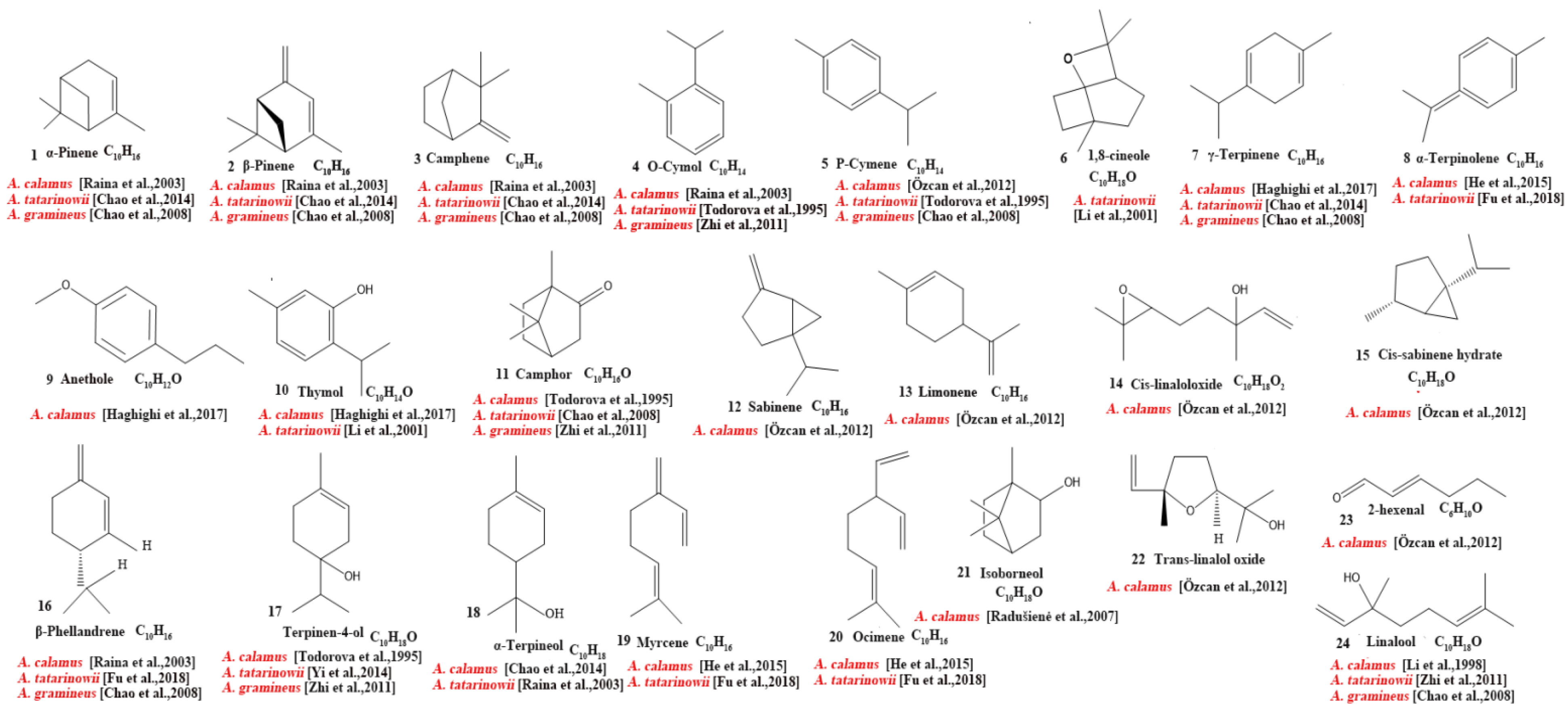
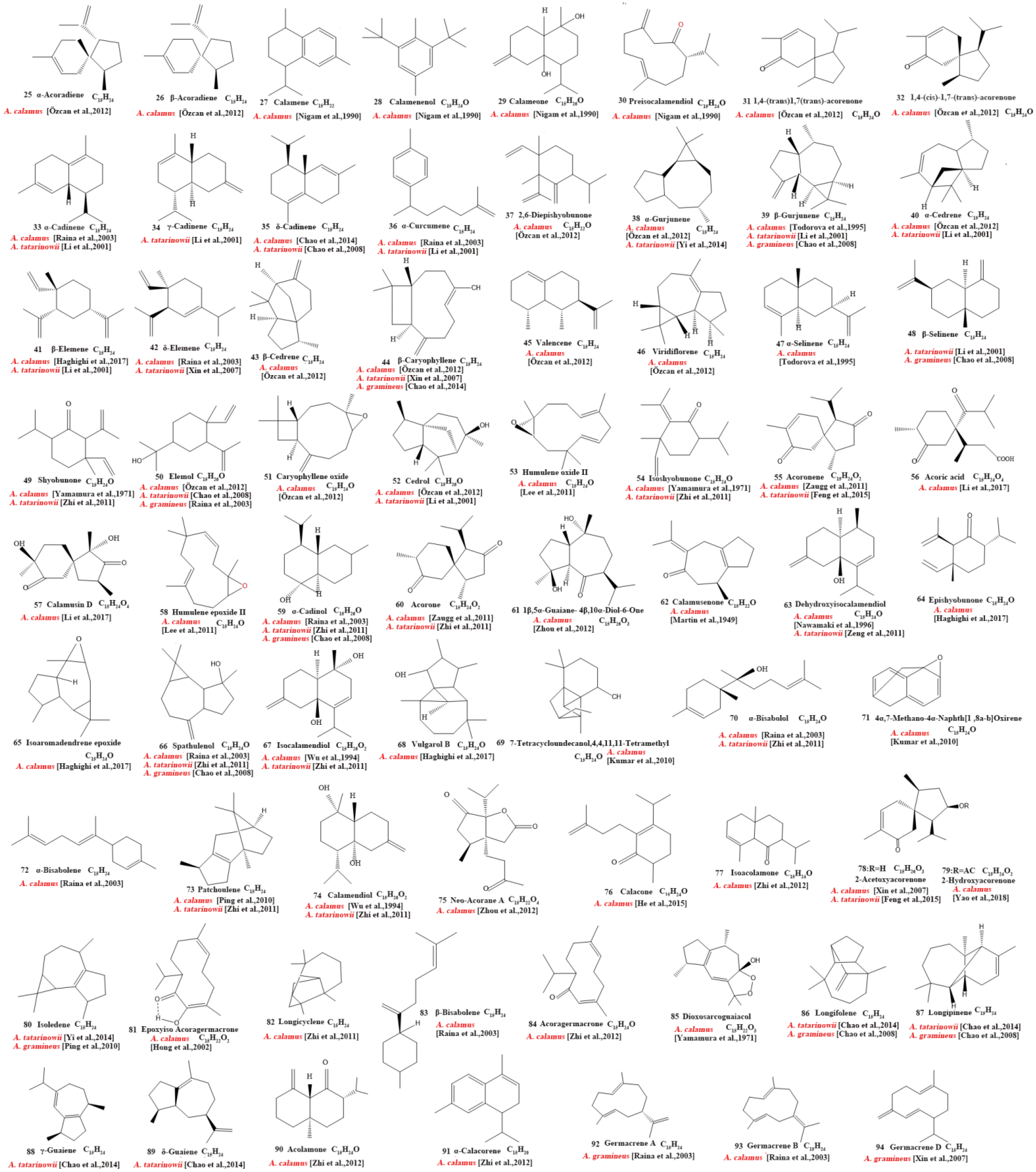
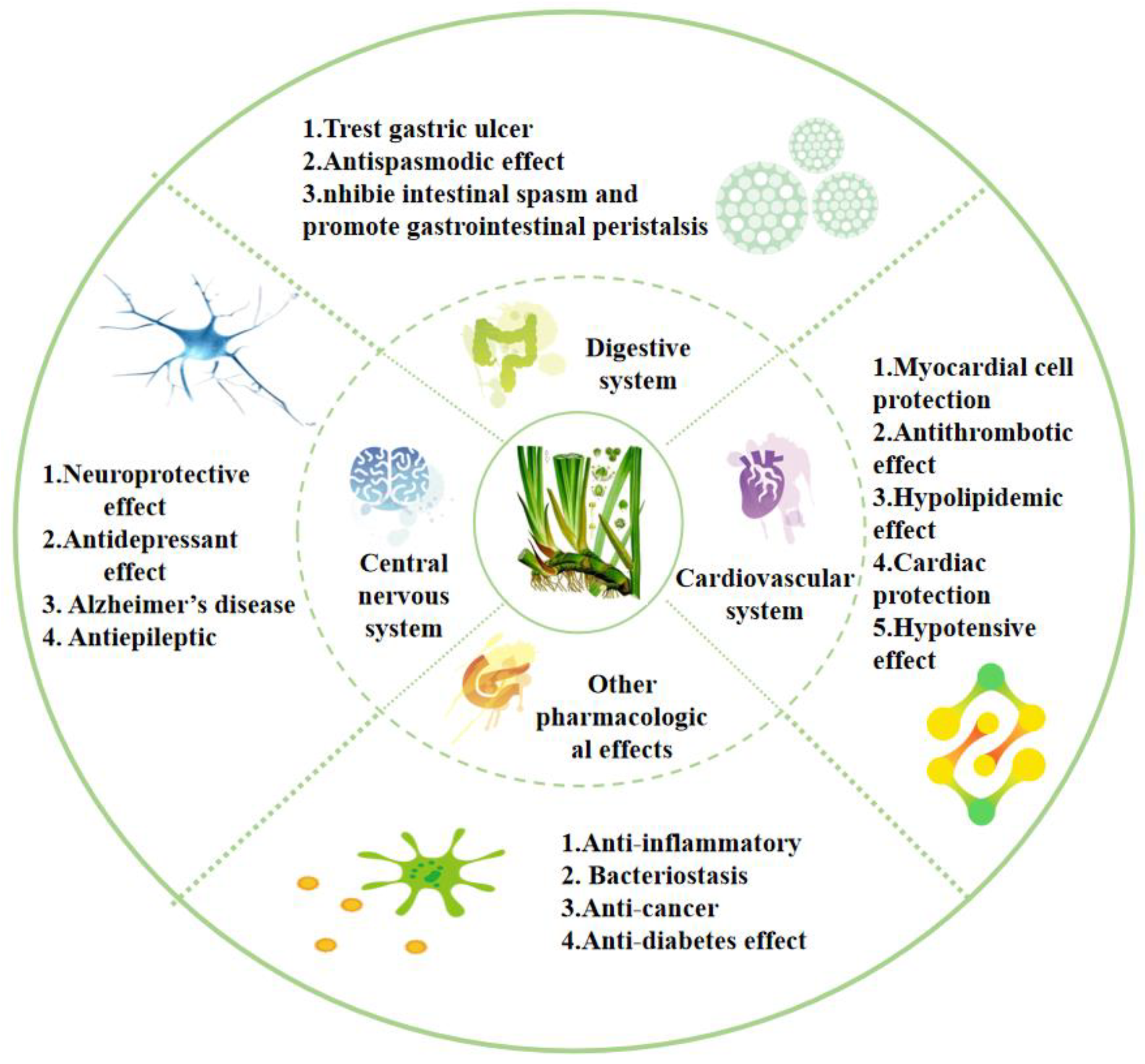
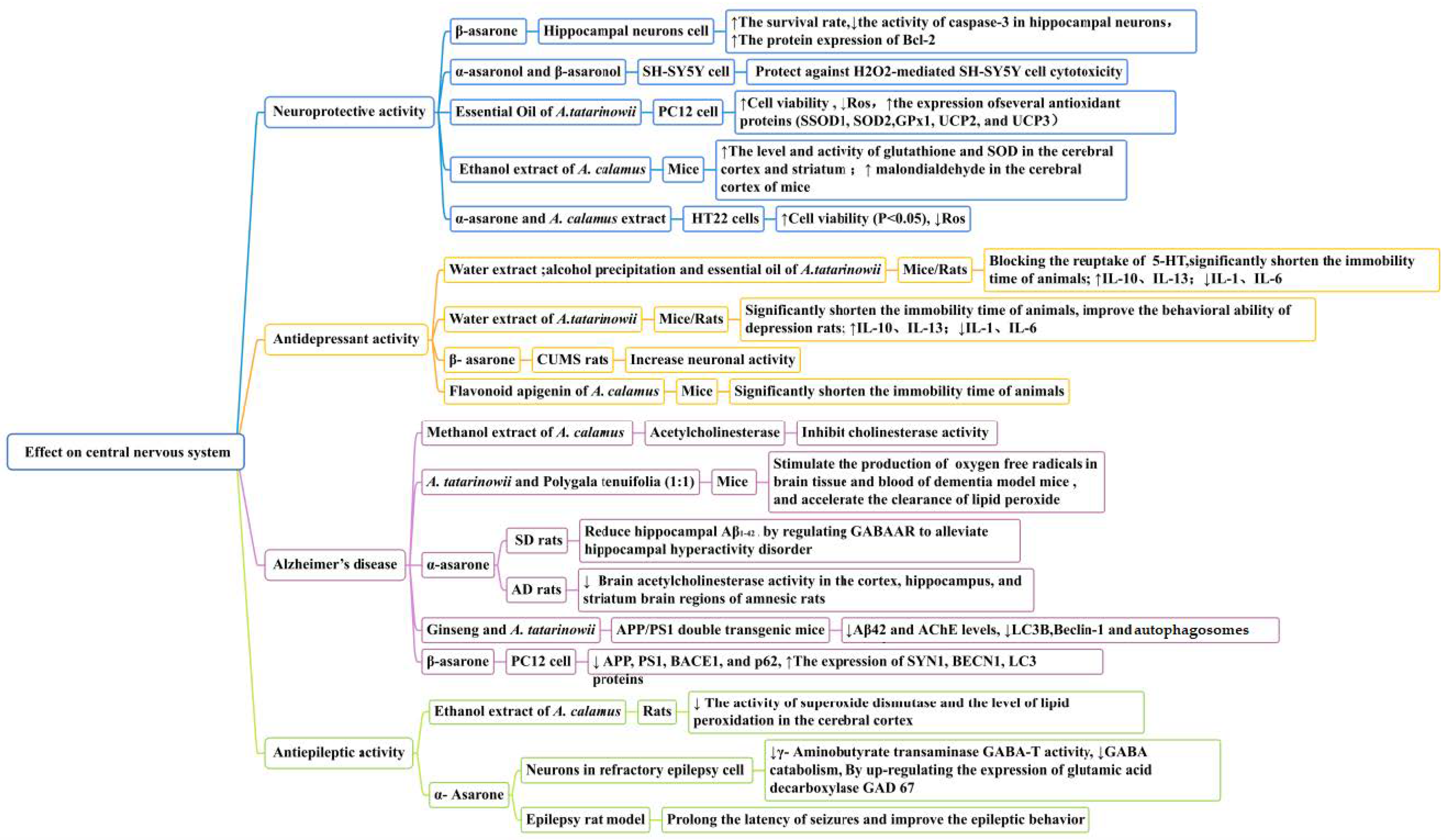

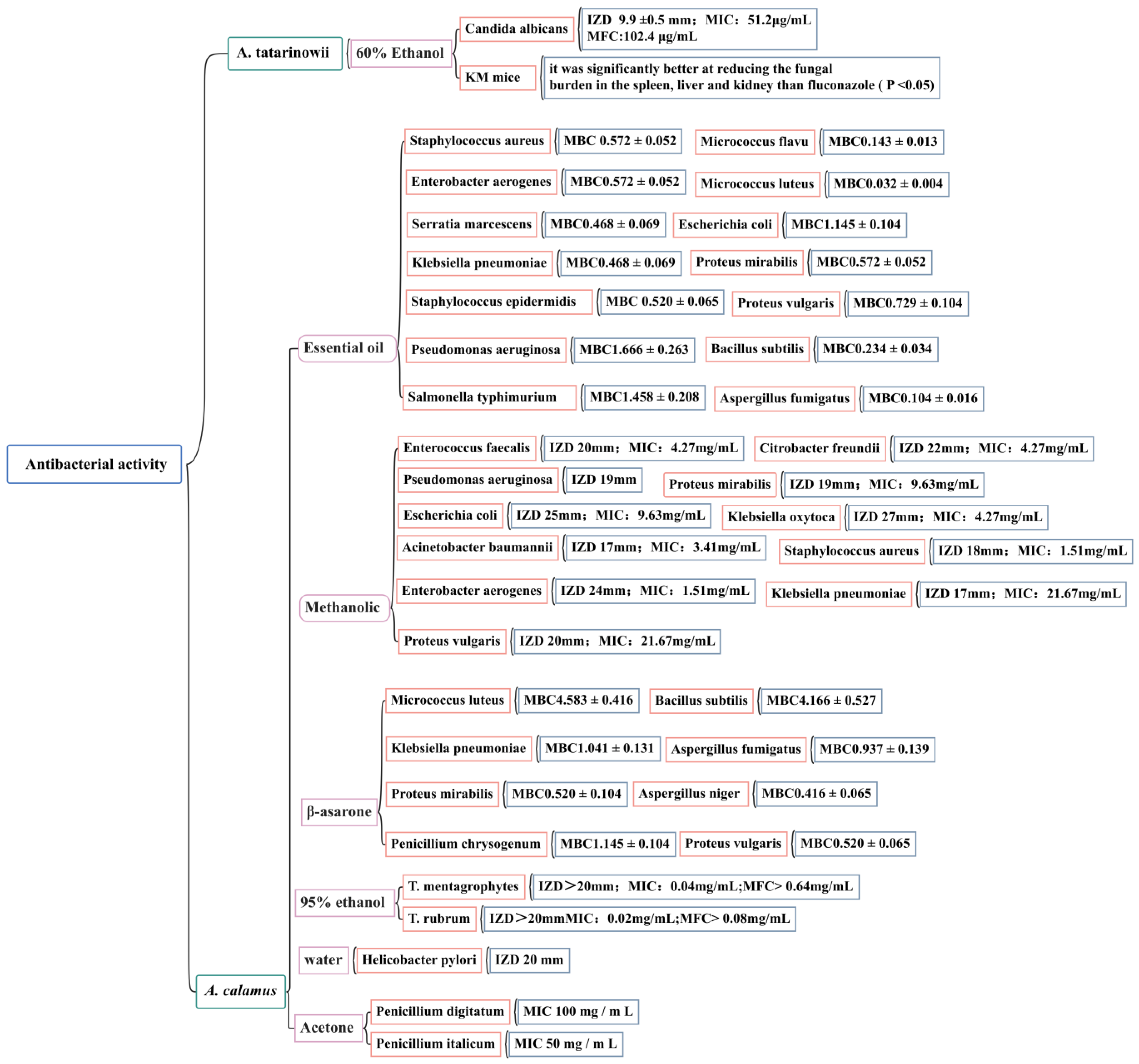

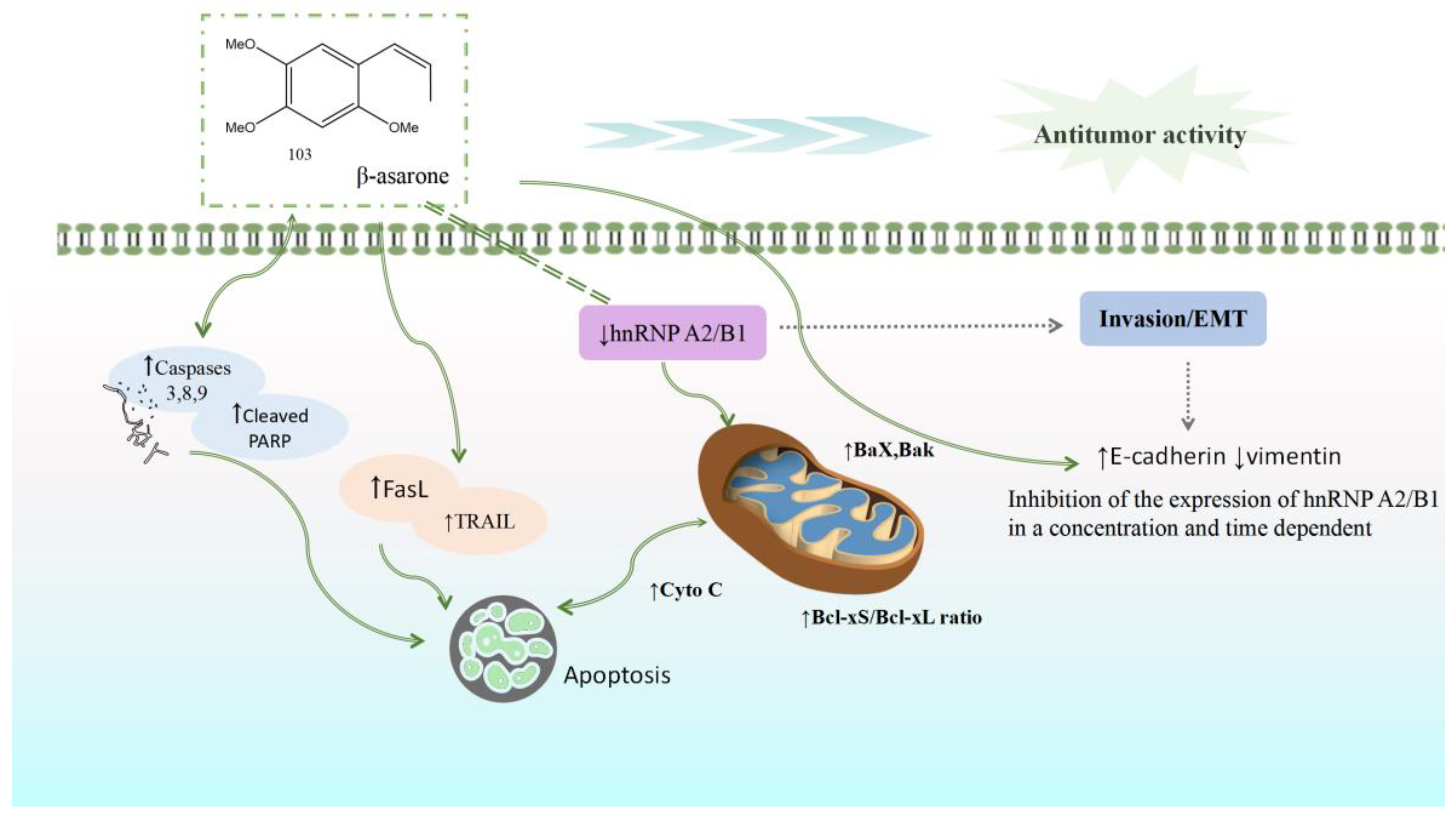


| Extract/ Compound | Animal/Cell Line | Mechanism/Results | Ref. |
|---|---|---|---|
| β-asarone (240 and 360 μM) | U251 cells | ↓ expression of hnRNP H1, hnRNPA2/B1, and cathepsin D | [144] |
| β-asarone (30 and 60 μM) | U251 cells | Inhibition of cell migration, invasion, and adhesion; EMT via the upregulation of E-cadherin and downregulation of vimentin. Inhibition of the expression of hnRNP A2/B1 in a concentration and time-dependent way. | [145] |
| β-asarone (60, 120, 240 and 480 μM) | U251 cells; glioma U251 tumor xenograft model (nude mice) | ↓ expression of matrix metalloproteinases (MMP-9) and p-STAT3.Cell cycle arrest at G1 phase, ↓ expression of matrix metalloproteinases (MMP-9) and p-STAT3. ↑ Bcl-xS/Bcl-xL, the inhibition of hnRNP A2/B1-mediated signaling pathway. Activation of the death receptor proteins TRAIL and FasL. Cleavage of caspase 8 and caspase 3. | [146] |
| β-asarone (200 and 400μM) | LoVo cells | Induced cell apoptosis via annexin V↓ mitochondrial membrane potential (MMP). ↑ proapoptotic proteins (Bax expression), and ↓ anti-apoptotic regulators Bcl-2, Bcl-xL | [147] |
| β-asarone (0, 10, 30 and 100 nM) (50, 100 and 200 μg/kg) | HT29 and SW480 cells; 1, 2-dimethyl hydrazine induced colorectal cancer mice | ↓ Bcl-2/Bax and ↑ the executer apoptosis enzyme caspase-9 and caspase-3 cascades. Induces cell senescence (SA-β-Gal activity). ↑in the levels of lamin B1, as well as p53, p21, and p15. Reduction in the incidence and number of formed tumors. Induction of senescence in human colorectal cancer via the activation of lamin B1 by promoting the tumor protein (p53, p21) expressions. | [148] |
| Ethanolic extracts of A. calamus (15, 30, 60, 120, 240 and 480 μg/mL) | AGS cells | Inhibit cell proliferation, cell cycle arrest at G1 phase. Inhibition of formation of tube-like structures confirming anti-angiogenic properties. | [149] |
| Ethanolic extracts of A. calamus (250, 500 and 750 μg//mL) | LNCaP cells | Inhibition of cell viability. Induces apoptotic cell death. | [36] |
Disclaimer/Publisher’s Note: The statements, opinions and data contained in all publications are solely those of the individual author(s) and contributor(s) and not of MDPI and/or the editor(s). MDPI and/or the editor(s) disclaim responsibility for any injury to people or property resulting from any ideas, methods, instructions or products referred to in the content. |
© 2023 by the authors. Licensee MDPI, Basel, Switzerland. This article is an open access article distributed under the terms and conditions of the Creative Commons Attribution (CC BY) license (https://creativecommons.org/licenses/by/4.0/).
Share and Cite
Zhao, Y.; Li, J.; Cao, G.; Zhao, D.; Li, G.; Zhang, H.; Yan, M. Ethnic, Botanic, Phytochemistry and Pharmacology of the Acorus L. Genus: A Review. Molecules 2023, 28, 7117. https://doi.org/10.3390/molecules28207117
Zhao Y, Li J, Cao G, Zhao D, Li G, Zhang H, Yan M. Ethnic, Botanic, Phytochemistry and Pharmacology of the Acorus L. Genus: A Review. Molecules. 2023; 28(20):7117. https://doi.org/10.3390/molecules28207117
Chicago/Turabian StyleZhao, Yu, Jia Li, Guoshi Cao, Daqing Zhao, Guangzhe Li, Hongyin Zhang, and Mingming Yan. 2023. "Ethnic, Botanic, Phytochemistry and Pharmacology of the Acorus L. Genus: A Review" Molecules 28, no. 20: 7117. https://doi.org/10.3390/molecules28207117
APA StyleZhao, Y., Li, J., Cao, G., Zhao, D., Li, G., Zhang, H., & Yan, M. (2023). Ethnic, Botanic, Phytochemistry and Pharmacology of the Acorus L. Genus: A Review. Molecules, 28(20), 7117. https://doi.org/10.3390/molecules28207117




